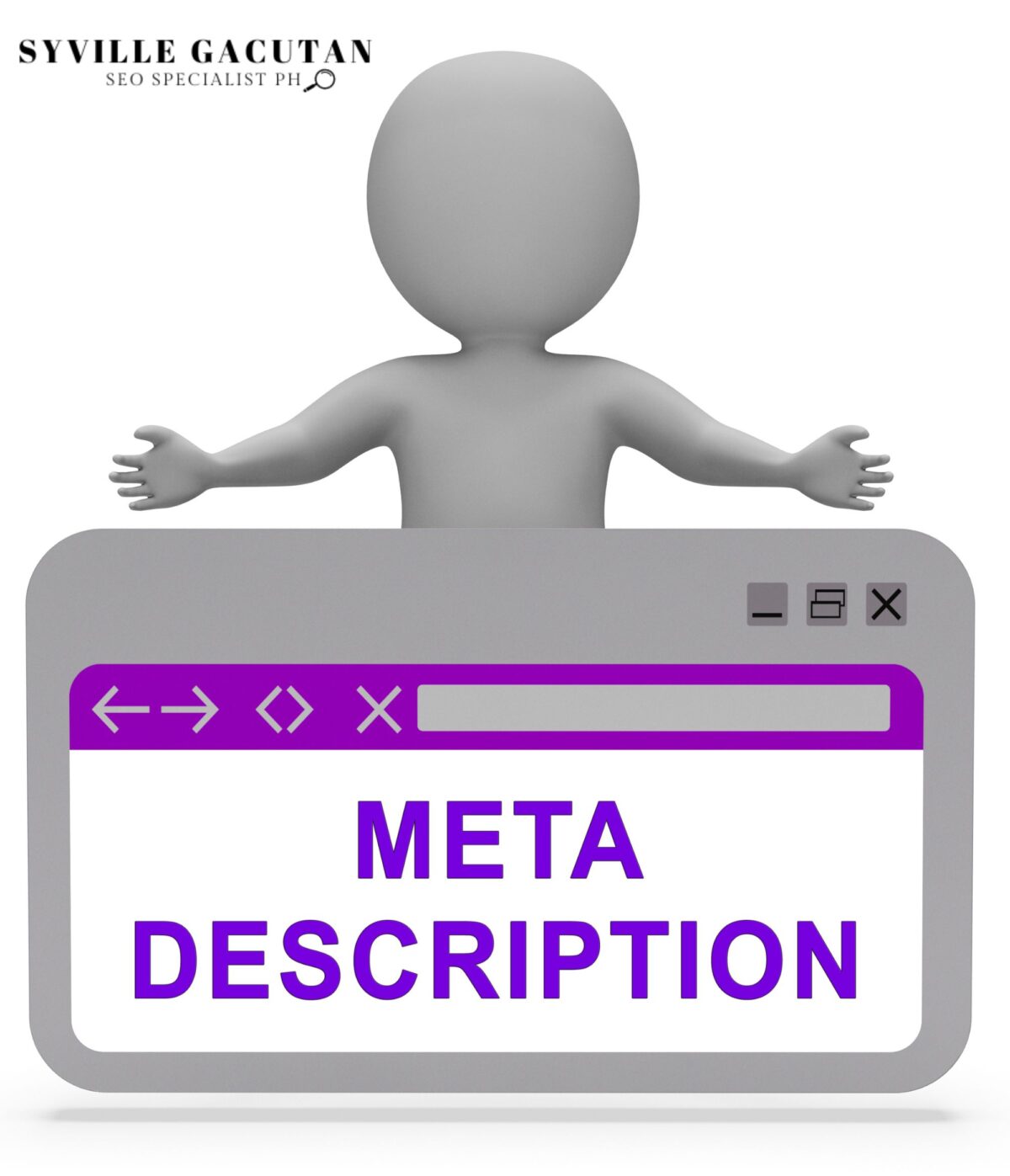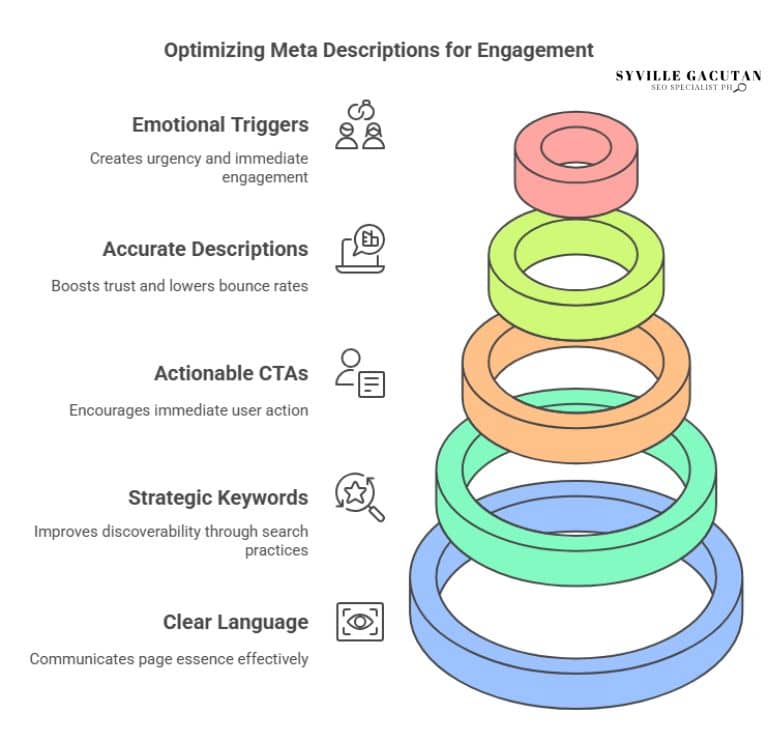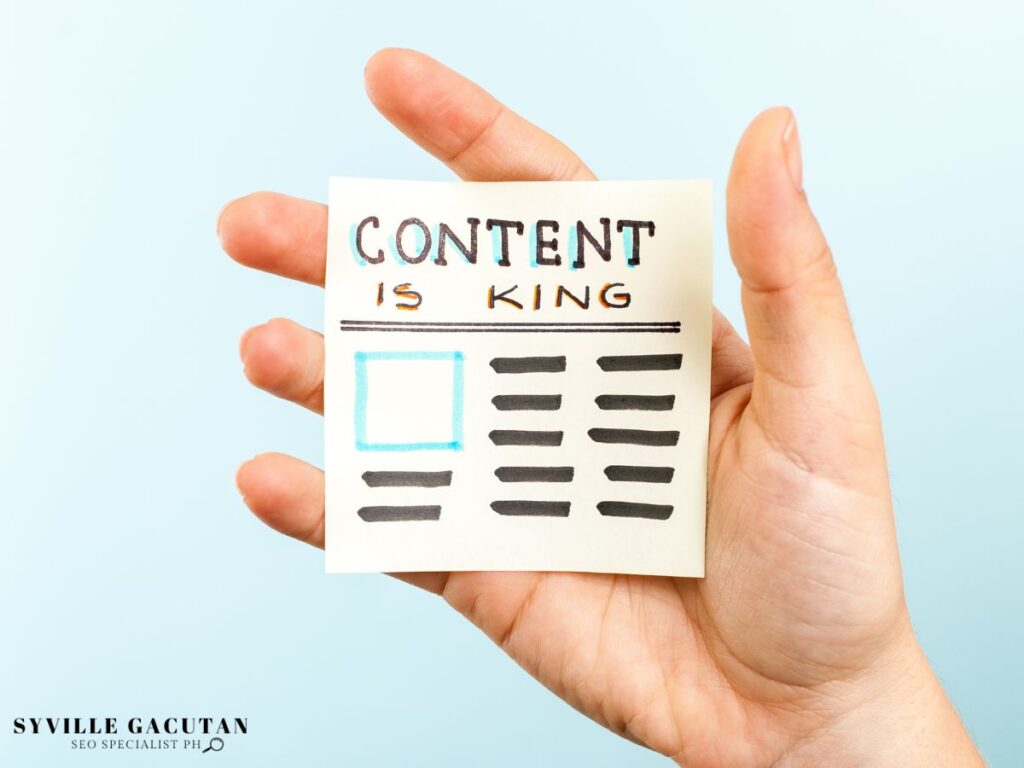
To effectively convey your content and make a compelling meta description, use clear language while strategically incorporating important keywords to improve visibility. An engaging meta description should include a persuasive call to action, like “Discover now,” to create a sense of urgency. Emotional triggers such as hope or excitement can also enhance click-through rates. Additionally, the description should accurately reflect the page’s content to build trust and reduce bounce rates. Crafting unique descriptions for each page ensures relevance and individuality. To uncover and know how to write effective meta descriptions, continue exploring .
Key Takeaways
- A compelling meta description uses clear, direct language to effectively communicate the page’s essence and attract potential readers.
- Because it is in line with user intent and industry-specific search practices, well placed keywords improve discoverability.
- Convincing wording and compelling calls to action encourage users to act right away, increasing click-through rates.
- Accurate descriptions that correspond with the page’s content boost trust and lower bounce rates.
- Users are encouraged to delve further into the content by the sensation of immediacy created by emotional triggers and urgency.

Clear and Concise

Crafting a clear and concise meta description is crucial for capturing the attention of potential clients. An effective meta description serves as a brief yet powerful introduction to your content, employing impactful language that resonates emotionally with your audience. By targeting the right audience with tailored messaging, you can significantly enhance engagement and encourage clicks through search engine results.
The art of writing a clear and concise meta description hinges on the application of clarity techniques. These techniques involve using simple, direct language that communicates the essence of your content without unnecessary embellishments. The goal is to ensure that the audience quickly understands what to expect from your page. This clarity, combined with precise audience targeting, helps in establishing an immediate connection and piquing the interest of potential visitors.
Readability factors also play an important role in crafting compelling meta descriptions. A well-structured description, free from jargon and complex sentence structures, promotes ease of understanding. It’s essential to strike a balance between being informative and sparking curiosity, ensuring that the description is neither too vague nor overly detailed. This balance will entice the reader to explore further, motivated by the promise of valuable content.
Incorporating emotional resonance into your meta descriptions can further enhance their effectiveness. By understanding the needs and desires of your target audience, you can choose words and phrases that evoke the right emotions. This connection can drive engagement, making the difference between a casual glance and a committed click, ultimately elevating the performance of your content in the digital landscape.
Incorporates Relevant Keywords

In the realm of SEO, incorporating relevant keywords into your meta descriptions is paramount to enhancing discoverability and driving traffic to your content. Effective keyword placement strategies hinge on a deep understanding of user intent and the ability to anticipate the terms potential readers might use when searching for content within your niche. Through competitive analysis techniques, you can discern which keywords are driving traffic to similar content, allowing you to tailor your meta descriptions accordingly.
Understanding the proper meta description length is equally crucial. Ideally, a meta description should be concise, yet informative, typically falling within the range of 150-160 characters to ensure it is fully displayed in search results. This limitation requires a strategic approach to keyword placement.
Consider the following table for industry-specific examples and guidance on effective keyword incorporation:
| Industry | Keyword Placement Strategy | Meta Description Length |
| Financial Advice | Focus on terms like “investment tips” and “savings plans,” ensuring they appear near the beginning for emphasis. | 155 characters |
| Technology | Utilize phrases such as “latest tech trends” and “AI development,” embedding them naturally within the first sentence. | 160 characters |
| Health & Wellness | Highlight keywords like “nutrition advice” and “fitness routines,” crafting descriptions that align with user queries. | 150 characters |
| E-commerce | Incorporate product-specific terms like “discount offers” and “new arrivals,” optimizing for shopper intent. | 158 characters |
Engages the User with a Call to Action

A compelling meta description serves as a virtual handshake, inviting users to explore your content further by incorporating a persuasive call to action (CTA). This element is crucial in aligning with user intent by tapping into their needs and desires. The primary aim is to engage the target audience through emotional appeal, ensuring the description resonates on a personal level.
By using persuasive language, it encourages users to take the next step, whether it’s to read more, learn about a service, or take advantage of an offer. Crafting an effective CTA involves understanding the actionable insights derived from analyzing user behavior. This knowledge allows for the creation of a meta description that not only attracts clicks but also fulfills the user’s purpose in seeking information.
For example, a financial advisor‘s webpage might use a CTA like “Discover how to secure your financial future today,” which directly addresses the audience’s intent of financial stability. The language used should be succinct yet powerful, capturing the essence of what the user can expect from the content.
Words like “explore,” “learn,” “find,” or “get started” are effective in prompting immediate engagement. The CTA should not only promise value but also create a sense of urgency or exclusivity, enhancing the emotional appeal.
Ultimately, a well-crafted CTA in a meta description can significantly improve click-through rates by bridging the gap between user curiosity and the valuable information contained within the webpage. This approach ensures that the user’s journey from search engine results to relevant content is seamless and rewarding.
Matches the Page Content

While a compelling call to action can captivate a user’s interest, ensuring that the meta description accurately reflects the page content is equally important. An effectively crafted meta description serves as a bridge between user expectations and the actual content of the page, directly impacting content relevance and audience targeting.
When a meta description aligns with user intent, it enhances the likelihood that users will engage with the content, thereby improving click through rates and contributing to successful search engine optimization strategies.
The essence of matching the meta description with the page content lies in its capacity to set accurate expectations. Misleading descriptions may lead to higher bounce rates, as users quickly leave pages that do not fulfill the promises made in search results.
Therefore, to maintain credibility and trust, it is imperative that descriptions are truthful and reflective of the actual content.
Consider the following when crafting meta descriptions:
- Content Relevance: Ensure that critical keywords and phrases from the page are incorporated, highlighting the essential aspects of the content.
- User Intent: Understand what users are searching for and tailor the description to meet those specific needs and queries.
- Search Engine Optimization: Properly align the meta description with SEO practices, using keywords strategically without resorting to keyword stuffing.
- Audience Targeting: Aim to address the interests and concerns of the intended audience, ensuring that the description speaks directly to them.
Ultimately, by matching the meta description with the page content, businesses can foster user trust, improve search engine rankings, and drive more targeted traffic to their site.
Creates a Sense of Urgency or Emotion

Crafting a meta description that evokes a sense of urgency or emotion can significantly enhance user engagement and drive click-through rates. By leveraging emotional triggers and urgency techniques, you can create persuasive language that captures attention and compels action. The goal is to instill a sense of immediacy, often through the fear of missing out, which can prompt users to click on your content without hesitation.
Consider the following emotional triggers and urgency techniques:
| Emotional Triggers | Urgency Techniques |
| Fear of Missing Out | Limited Time Offers |
| Desire for Belonging | Countdown Timers |
| Hope and Inspiration | Exclusive Access |
| Trust and Security | While Supplies Last |
| Excitement and Anticipation | Act Now! |
Incorporating action-oriented phrases into your meta descriptions is vital to achieving this. For instance, phrases like “Discover now,” “Unlock exclusive access,” or “Join the community today” not only appeal to users’ emotions but also encourage immediate engagement. The persuasive language used in these descriptions should resonate with the target audience, making them feel that the opportunity presented is fleeting and must be seized promptly.
Moreover, the strategic use of emotional triggers such as excitement or security can make your content more relatable and appealing. By tapping into users’ intrinsic motivations and desires, you can craft meta descriptions that are more compelling and likely to result in higher click-through rates. Ultimately, the effective combination of urgency techniques and emotional resonance is key to creating descriptions that not only attract attention but also prompt decisive action from potential visitors.
Unique to Each Page
Each page on your website should have a distinctive meta description tailored to its specific content and purpose. This approach not only enhances page relevance but also ensures your descriptions are finely tuned for audience targeting. By crafting unique meta descriptions, you align the content naturally with the user’s search intent, which can significantly improve click-through rates.
A one-size-fits-all strategy can result in missed opportunities and diluted messaging, whereas bespoke descriptions reflect the individuality and specific value of each page.
Implementing unique meta descriptions requires thorough competitive analysis. By understanding what competitors are doing, you can identify gaps or opportunities to differentiate your content. This analysis is essential in developing optimization strategies that make your pages stand out in search engine results.
Moreover, content alignment with the meta description is crucial; it ensures that the promise made in the description is fulfilled by the content on the page, fostering trust and credibility with your audience.
A compelling meta description should be:
- Reflective of Page Content: Clearly indicate what users can expect, maintaining transparency and relevance.
- Targeted to the Audience: Use language and keywords that resonate with the specific needs and interests of your audience.
- Unique and Distinctive: Differentiate your page from others by highlighting unique selling points or features.
- Consistent with Optimization Goals: Align with broader SEO strategies to support improved visibility and engagement.
Final Thoughts
Crafting compelling meta descriptions is essential for enhancing your website’s visibility and driving higher click-through rates. By using clear language, strategically incorporating relevant keywords, and creating engaging calls to action, you can effectively capture user interest. It’s important to ensure that your descriptions accurately reflect the page’s content to build trust and lower bounce rates. Additionally, incorporating emotional triggers and a sense of urgency can motivate users to take immediate action. Remember to create unique descriptions for each page, aligning them with user intent and optimizing for different devices.
Need help perfecting your meta descriptions and boosting your website’s SEO performance? Syville Gacutan, an experienced SEO Specialist in the Philippines, can help you optimize your content strategy, enhance visibility, and drive user engagement. Contact Syville today to take your SEO to the next level!